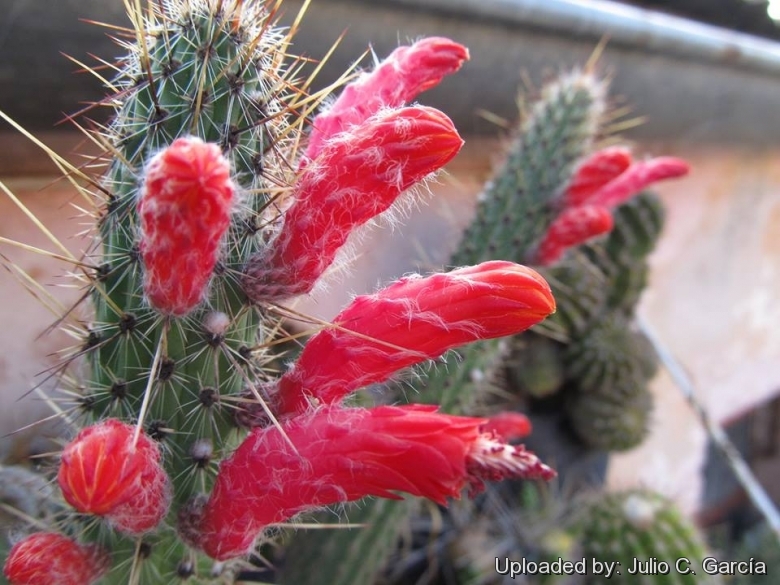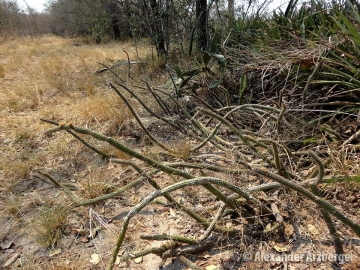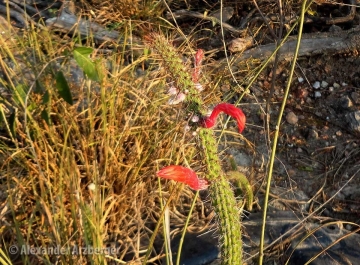Accepted Scientific Name: Cleistocactus baumannii (Lem.) Lem.
Ill. Hort. 8: Misc. 35. 1861 [Jun 1861]

Aporocactus baumannii (Cleistocactus baumannii) Photo by: Julio C. García
Origin and Habitat: Cleistocactus baumanniiSN|4742]]SN|4742]] is widely distributed in the Chaco of Bolivia, western Argentina, Uruguay and Paraguay.
Altitude range: It occurs at elevations between 10 and 1,000 metres above sea level.
Habitat and Ecology: This cactus grows in sandy and clayey soils, in forest borders as well as within dense or open forests. It can also be found in the scrubs of the dry Chaco and in the eastern region of Paraguay. Furthermore, it grows in rocky areas and open sites. This species is locally abundant and favored by anthropogenic activities, and there are no major threats affecting it. It also occurs in many protected areas. The Chacoan peccary (Catagonus wagneri) eats this cactus mostly in the dry season.
Synonyms:
See all synonyms of Cleistocactus baumannii
Common Names include:
ENGLISH: Firecracker cactus, Scarlet bugler
Description: Cleistocactus baumanniiSN|4742]]SN|4742]] is a columnar cactus with several thin ribbed stems branching at base, covered with whitish spines, sometimes yellow or brown. Flowers are tubular and orange-scarlet, slightly open showing only the style and stamens. Six subspecies are recognized, the nominate, subsp. horstii (P.J.Braun) N.P.Taylor, subsp. anguinus (Gurke) P.J.Braun&Esteves, subsp. croceiflorus (F. Ritter) P. J. Braun & Esteves, subsp. chacoanus (F. Ritter) P. J. Braun & Esteves and subsp. sanctacruzensis (Backeb.) Mottram.
Stems: Somewhat branching at base, fairly stiff, erect or arching, 2 meters high or more, 2.5 to 3.5 cm. in diameter, dark green.
Ribs: 12 to 16, low.
Areoles: Approximate, brown or black-felted.
Central spine: One, yellowish or dark brown, 4 cm or less long.
Radial spines: Needle-like, 8 to 20, white, yellow, or brown to 1.8 cm long.
Flowers: Born along the stem over several months in summer, yellow-orange to scarlet, 5 to 7 cm long, narrow, 1 cm in diameter, sharply upcurved, and then narrowly S-shaped beyond the pericarpel, with oblique corolla; scales on ovary and flower-tube ovate, acute; perianth-segments short and broad, acute. Stamens red numerous, appressed against the upper part of the flower-tube. Stamens and style exserted.
Fruit: Spherical, 1 to 1.5 cm in diameter, pink to red with white pulp, edible.
Subspecies, varieties, forms and cultivars of plants belonging to the Cleistocactus baumannii group
 Cleistocactus baumannii (Lem.) Lem.: (subsp. baumannii) has 15-20 radial spines and red flowers. Distribution:Northeastern Argentina, Paraguay, and Uruguay.
Cleistocactus baumannii (Lem.) Lem.: (subsp. baumannii) has 15-20 radial spines and red flowers. Distribution:Northeastern Argentina, Paraguay, and Uruguay.- Cleistocactus baumannii subs. anguinus (Gürke) P.J.Braun & Esteves: decumbent with 10-11 radial spines and yellow-orange or orange-red flowers. Distribution: Paraguay.
 Cleistocactus baumannii subs. chacoanus (F.Ritter) P.J.Braun & Esteves: has more erect shoots, with less ribs, 12-15 radial spines and shorter bilaterally symmetrical flowers, usually red. Distribution: Gran Chaco region of Bolivia.
Cleistocactus baumannii subs. chacoanus (F.Ritter) P.J.Braun & Esteves: has more erect shoots, with less ribs, 12-15 radial spines and shorter bilaterally symmetrical flowers, usually red. Distribution: Gran Chaco region of Bolivia.- Cleistocactus baumannii subs. croceiflorus (F.Ritter) P.J.Braun & Esteves: has 8-12 radial spines and yellow flowers. Distribution: Puerto Casado, Alto Paraguay department, Paraguay.
 Cleistocactus baumannii subs. horstii (P.J.Braun) N.P.Taylor: has 11-15 radial spines and bilaterally symmetrical flowers, orange-red. Distribution: Mato Grosso do Sul, Brazil.
Cleistocactus baumannii subs. horstii (P.J.Braun) N.P.Taylor: has 11-15 radial spines and bilaterally symmetrical flowers, orange-red. Distribution: Mato Grosso do Sul, Brazil. Cleistocactus baumannii var. paraguariensis (F.Ritter) P.J.Braun & Esteves: 12-15, yellow to reddish yellow with darker tips, and 4-5, reddish brown centrals. Distribution: Paraguari department, Paraguay.
Cleistocactus baumannii var. paraguariensis (F.Ritter) P.J.Braun & Esteves: 12-15, yellow to reddish yellow with darker tips, and 4-5, reddish brown centrals. Distribution: Paraguari department, Paraguay.- Cleistocactus baumannii subs. santacruzensis (Backeb.) Mottram: has fewer but more elevated ribs, only about 10 radial spines and red flowers (perhaps the same as subsp. anguinus), Anthers barely protruding. Distribution: Santa Cruz, Bolivia.
- Cleistocactus bruneispinus Backeb.: has brown spines. Distribution Cochabamba, Bolivia.
- Cleistocactus margaritanus hort.: has dense yellowish bristly soft spines and orange-red S-shaped blooms, and seems related to subs. chacoanus. Distribution: Margarita, Tarija, Bolivia
- Cleistocactus margaritanus f. cristatus hort.: crested form.
Bibliography: Major references and further lectures
1) James Cullen, Sabina G. Knees, H. Suzanne Cubey “The European Garden Flora Flowering Plants: A Manual for the Identification of Plants Cultivated in Europe, Both Out-of-Doors and Under Glass” Cambridge University Press, 11/Aug./2011
2) David Hunt, Nigel Taylor “The New Cactus Lexicon” DH Books, 2006
3) Edward F. Anderson “The Cactus Family” Timber Press, 2001
4) Urs Eggli, Leonard E. Newton “Glossary of Botanical Terms with Special Reference to Succulent Plants.” British Cactus and Succulent Society, Richmond 1993
5) Gurcharan Singh Randhawa, Amitabha Mukhopadhyay “Floriculture in India” Allied Publishers, 01/Jan/1986
6) Oakley, L. & Pin, A. 2013. Cleistocactus baumannii. The IUCN Red List of Threatened Species. Version 2014.2. <www.iucnredlist.org>. Downloaded on 07 August 2014
7) N. L. Britton and J. N. Rose “The 'Cactaceae', Descriptions and Illustrations of Plants of the 'Cactus' Family” volume 2 Carnegie Institution, 1920
8) Navarro, G. “Catálago ecológico preliminar de las cactáceas de Bolivia.” Lazaroa 17: 33–84. 1996
9) Serrano, M. & J. Terán. “Identific. Esp. Veg. Chuquisaca” 1–129. PLAFOR, Intercooperación, Fundación Ceibo, Sucre. 1998 [2000].
10) Zuloaga, F.O., O. Morrone, M. J. Belgrano, C. Marticorena & E. Marchesi. (eds.). “Catálogo de las Plantas Vasculares del Cono Sur (Argentina, Sur de Brasil, Chile, Paraguay y Uruguay).” in Monogr. Syst. Bot. Missouri Bot. Gard. 107(1): i–xcvi, 1–983; 107(2): i–xx, 985–2286; 107(3): i–xxi, 2287–3348. 2008
 Growing habit, Mato Grosso do Sul, Brasil. (Cleistocactus baumannii) Photo by: Alexander Arzberger
Growing habit, Mato Grosso do Sul, Brasil. (Cleistocactus baumannii) Photo by: Alexander Arzberger Blooming habit, Mato Grosso do Sul, Brasil. (Cleistocactus baumannii) Photo by: Alexander Arzberger
Blooming habit, Mato Grosso do Sul, Brasil. (Cleistocactus baumannii) Photo by: Alexander Arzberger Cleistocactus baumannii var., Mato Grosso do Sul, Brasil. (subs. horstii ?) (Cleistocactus baumannii) Photo by: Alexander Arzberger
Cleistocactus baumannii var., Mato Grosso do Sul, Brasil. (subs. horstii ?) (Cleistocactus baumannii) Photo by: Alexander Arzberger Aporocactus baumannii (Cleistocactus baumannii) Photo by: Alexander Arzberger
Aporocactus baumannii (Cleistocactus baumannii) Photo by: Alexander ArzbergerCultivation and Propagation: Cleistocactus baumanniiSN|4742]]SN|4742]] is a a much decorative hardy cactus. It is very easy to grow but tends to look untidy in the collection if not staked. It is recommended as one of the best of the sprawling Cleistocactus forms, with the added benefit of being reliably hardy.
Growth rate: Cleistocactus baumanniiSN|4742]]SN|4742]] grows rapidly enough to need pruning.
Soil: Grow it in a rich and particularly draining substratum, as it is very sensitive to rottenness when in presence of humidity and low temperatures and let the soil dry out between waterings.
Water: It needs plenty of water in the summer (during the vegetative period) when it will flower for months, but allowing the substratum to completely dry up before irrigating again; in winter, it’s to be kept dry. Preferable not to water on overcast days, humid days or cold winter days.
Hardiness: This is one of hardiest of the woolly columnar cacti from Bolivia that grow at an altitude of up to 1000 meters. It is a frost resistant cactus, hardy to -7°(or even less if very dry). However in cultivation it is better not to expose it to temperatures lower than 0° C, even if in an aerated and protected location, in order to avoid the formation of anti-aesthetic spots on the epidermis. In presence of high atmospheric humidity avoid any frost as it is particularly sensitive to root rot.
Exposure: It need full sun exposures with ample airflow to produce dense hairs, but, as a former mountain dweller, does not care for extremely high temperatures in summer.
Maintenance: Repot in the spring, when their roots become cramped. Generally, they should be repotted every other year in order to provide fresh soil. After repotting, do not water for a week or more. As with many cleistocacti, the flowers are produced in profusion: the dead ones just fall off so need to be regularly tidied up. It will probably benefit from the occasional pruning to keep it in check and provide cuttings for propagation. Otdoors clumps need renewal after five to ten years, done by removing old growth.
Use: Excellent as landscape or patio plant. It is suitable for small “desert” gardens, in association with other xerophytes. Where the open air cultivation is not possible due to the climate, it is to be cultivated in pot in order to shelter it in winter.
Propagation: By seeds and by cuttings, provided left drying up well, in summer.














